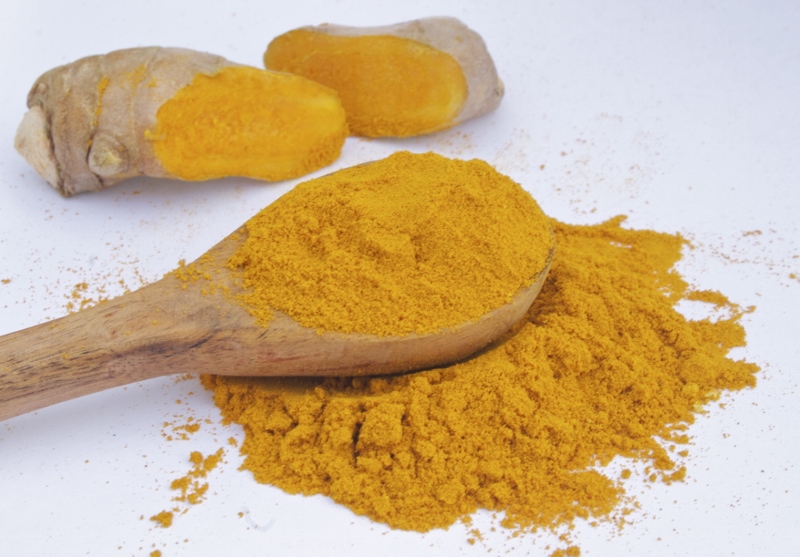Turmeric: A Spice More Valuable Than Gold
General
Turmeric (curcuma longa), an herbaceous member of the ginger family, has been popular in India and Southeast Asia for thousands of years as a spice and medicine; today, it is the subject of widespread study and there is speculation that we have only scratched the surface of its medicinal properties. Turmeric has been assigned more than 35 different names, including bhadra (lucky), jayanti (one that wins over disease), and tamasini (beautiful as night). Above ground, turmeric sprouts in clusters of wide, waxy green leaves and vibrant pink and purple flowers. Its roots are thick and knobbly, much like ginger, with a rich orange-yellow flesh. These roots are typically dried and powdered prior to use as an ingredient or dye – turmeric is well-known for its savory, distinctive flavor and rich coloration.

Traditional and Contemporary Medical Applications
Turmeric was ascribed many uses as a traditional medicine, including the relief of abdominal pain, liver ailments, and use as a general disinfectant for injuries. Although there is not yet a large enough body of study for turmeric to be adopted by Western medicine, preliminary reports indicate very strongly that turmeric possesses a myriad of beneficial qualities. Initially, scientific interest was piqued by the fact that India, where turmeric is widely consumed as a part of the standard Indian diet, exhibits far lower instances of nearly every strain of major cancer. For instance, the US reports 20 times more annual cases of prostate cancer than India, and as many as 15 times the cases of lung cancer. These disparities are believed to have dietary roots; 40% of Indians are vegetarian, and the array of spices common to the Indian diet (turmeric included) is simply not present in the typical American diet. Recent trials have also shown turmeric to be effective in treating stomach ulcers, relieving irritable bowel syndrome (IBS), and broadly as an anti-inflammatory agent for the treatment of infection or the symptoms of arthritis. The body of knowledge regarding turmeric as a medicine is not stagnant; in the last 25 years more than 3,000 articles, reports, and investigations of turmeric’s properties have been published. This golden root has a great deal more to offer the world than its remarkable hue and flavor.
Origins and Early Uses
Although currently popular all over the world, turmeric’s origins can be traced back to India (where certain regions are named for local strains of turmeric) and Southeast Asia, where it played a variety of important cultural roles. Most often turmeric was used as a spice and dye to enliven the palette and the palate of traditional dishes, lending a savory edge or a brilliant tinge of gold to a meal. In India turmeric was believed to be holy (yellow being the color of the sun), and was traditionally used in Hindu marriage ceremonies and to dye Hindu monks’ robes in their distinctive range of yellow/orange/red colors. Today, India produces the vast majority of the world’s turmeric and, appropriately enough, consumes 80% of this output.
For more in depth information: here is a very informative article and infographic about turmeric and its health benefits written by Lyfe Botanicals.
Sources and Further Reading:
The National Center For Biotechnical Information has made the book “Herbal Medicine: Biomolecular and Clinical Aspects. 2nd edition.” available online. Chapter 13 is about turmeric and has 147 references, making it a comprehensive survey of turmeric. The National Institute of Health has an entry about turmeric that, having been reviewed in February of 2015, is more recent than any of our other sources and since it contains 2,147 references should be considered an authority on turmeric. In the USDA’s National Nutrient Database you can see the exact amounts of minerals, vitamins and lipids found in powdered turmeric. The American Cancer Society reports about the history of turmeric and its possible connection to cancer prevention. WebMD, a well known online reference for medical information, has an entry about turmeric, containing an “Overview”, “Uses”, “Side Effects”, and “Interactions” and “Dosing”. Drugs.com has a detailed but not overwhelming entry about turmeric, which was prepared by Wolters Kluwer Health, a “leading provider of information for professionals and students in medicine, nursing, allied health and pharmacy” , and contains some 48 sources.
Turmeric in the News and Blogosphere:
Many blog postings and news articles discuss turmeric and health benefits. These articles are easier to read but they are primarily reinterpretations of actual studies and therefore should not be taken as facts. We list a few below. Maine News Only talks about 14 possible benefits of turmeric. Dr. Andrew Weil, the Founder and Director of the Arizona Center for Integrative Medicine, had an article published in the Huffington Post titled “Turmeric Health Benefits: Have a Happy New Year With Turmeric”
